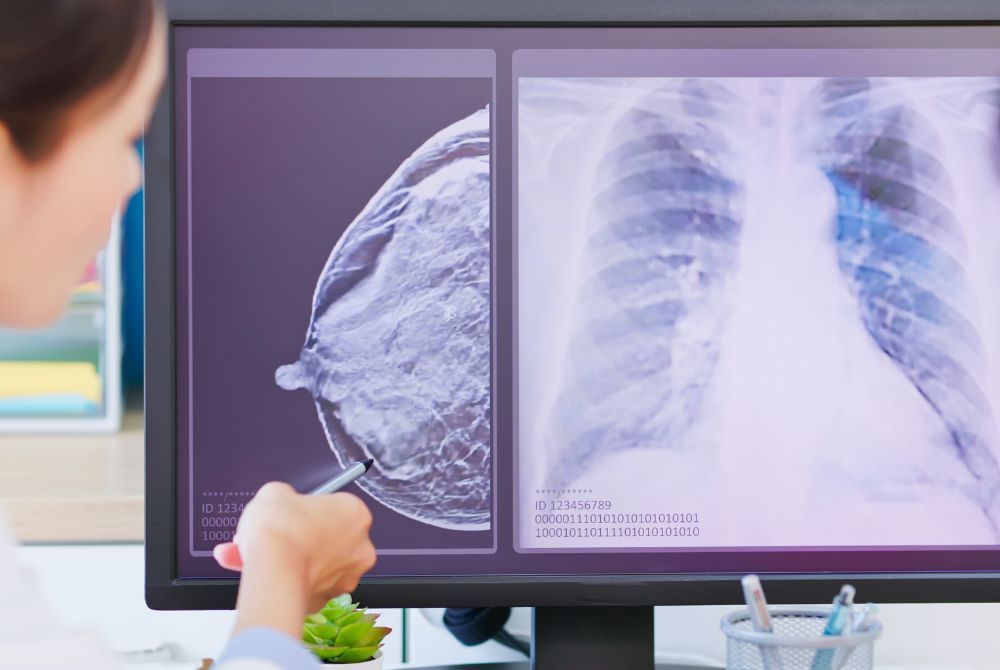
Introduction
Breast cancer develops regularly in women across all nations. Early detection of breast cancer leads to better treatment options and increases survival chances. The ability to detect breast cancer through screening helps find cancer developments earlier than patients show symptoms. The breast ultrasound test stands out as a first-rate diagnostic method for women with denser breast tissues. This article explains how ultrasound helps find breast cancer at an early stage, along with its advantages and the reasons for performing an ultrasound guided biopsy.
Early Signs of Breast Cancer
Identifying breast cancer signs early helps people get medical care right away and raises their chances of recovery. Some warning signs include:
- A lump or thickening in the breast or underarm
- Changes in breast size or shape
- Unexplained pain in the breast or nipple
- Nipple discharge (other than breast milk)
- Skin dimpling or redness
Immediate breast cancer screening, if these symptoms show because they need medical testing to find the source.
The Role of Breast Ultrasound in Screening
A breast ultrasound procedure takes images of breast tissue without entering the body through sound wave technology. It is particularly helpful for:
- The advantages of mammography tests are limited for women with dense breast tissue because the benefits decrease.
- The test finds out whether breast changes contain firm areas or liquid-filled sacs.
- Ultrasound technology helps medical teams place biopsies at specific breast tissue areas.
Advantages of Breast Ultrasound
- Safe and non-invasive: No radiation exposure
- Effective for dense tissue: The procedure works well for women with dense breasts since it shows results that standard mammography tests cannot find.
- Quick and painless: ultrasound screenings last 15 to 30 minutes without causing discomfort to the patient.
How Ultrasound Helps in Breast Cancer Detection
Women with dense breasts benefit from ultrasound because mammography falls short in showing clear images. Breast ultrasound scanning enables us to benefit from this procedure.
- Ultrasound scans find breast tumors that screening mammograms cannot locate
- Our tests look at breast areas that cannot be sensed by hand.
- Doctors use ultrasound to see how breast problems develop from one appointment to the next.
- Assisting in targeted biopsies.
Understanding Ultrasound Guided Biopsy
During diagnosis, doctors insert needles into the suspicious area using an ultrasound machine to collect tissue for medical tests. The technique helps us select the right tissue areas and decreases the pain experience. A biopsy under ultrasound control helps doctors know if a growth in the breast is malignant or harmless.
Benefits of Ultrasound Guided Biopsy
- Minimally invasive:Requires only a small incision
- Accurate:Targets the exact location of abnormalities
- Quick recovery: No need for stitches , and minimal downtime
Non Invasive Breast Cancer Detection
Doctor examinations find some breast problems do not need surgery. By using ultrasound to see breast tissue changes, doctors can prevent people from getting extra medical procedures they do not need. Ultrasound serves as a good option for breast cancer screening because it helps women avoid tougher examination methods.
Comparing Breast Ultrasound with Other Screening Methods
Mammogram vs. Breast Ultrasound
- Doctors must use mammograms differently to find breast cancer because they show less detail in tissues that are packed with small spots.
- Using breast ultrasound detects more problems in breast tissue stacks than traditional methods alone.
MRI vs. Breast Ultrasound
- The extensive details in MRI scans come with higher costs and are used only when necessary.
- Accomplishing diagnosis of suspicious breast lumps costs less while using ultrasound technology.
When Should You Get a Breast Ultrasound?
A doctor will order a breast ultrasound procedure based on these situations:
- The recommended time for a breast ultrasound test is when you show initial breast cancer warning signs.
- Your doctor will need further testing when mammogram results cannot answer all needed questions
- The test helps evaluate your situation when you have dense breast tissue
- During a routine physical check-up, doctors will notice unusual texture changes.
- Women who breastfeed and are pregnant should consider this non-radiation test screening.
Conclusion
Breast cancer testing by ultrasound should remain a standard practice for women who have dense breasts. When you detect any potential breast cancer warning signs, you need to see a medical expert to begin your breast ultrasound procedures immediately. The sooner doctors locate breast cancer through ultrasound tests, the better chance patients have of survival.
Our medical center offers total breast cancer screenings with both ultrasound guided biopsy and examinations for non invasive breast cancer patients.
Book your visit now at Ovum Hospitals.
FAQs
1: Is a breast ultrasound painful?
The breast ultrasound procedure feels comfortable and does not harm the patient.
2: Can ultrasound replace mammograms?
For women with dense breast tissue, a breast ultrasound offers important extra screening value.
3: How long does a breast ultrasound take?
Typically, it takes 15-30 minutes.
4: What if the ultrasound finds something suspicious?
When the ultrasound detects possible issues, our doctor will propose an ultrasound guided biopsy.
To investigate further, specialists may need to use ultrasound to guide a biopsy test.
5: Is breast ultrasound safe during pregnancy?
The procedure provides a safe breast examination because it does not rely on radiation during pregnancy.
6: When should I proceed with breast ultrasound tests according to my doctor?
Talk to your doctor about what screening plan is right for you when your breast tissue is dense or your risk of breast cancer is high.
7: Can breast ultrasound detect all types of breast cancer?
Breast ultrasound cannot find every type of breast cancer in the body.
Breast ultrasound helps detect cancer, but doctors achieve better results through regular mammograms and other types of scans when monitoring a patient's breast.
.png?updatedAt=1705732823811)

.png?updatedAt=1693463514059)
